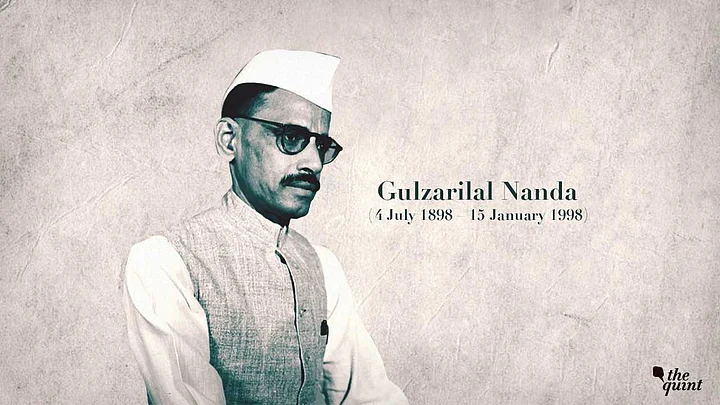(This article was first published on 14 January 2019. It has been reposted from The Quint’s archives to mark Gulzarilal Nanda’s death anniversary.)
Not many would disagree that one bit of trivia to make its way through to quiz books right since the mid-60s was about a certain Gulzarilal Nanda, who twice took oath as the Prime Minister of the country, though as an ‘acting’ one on both occasions.
One might wonder if people would still be interested in Nanda had he not made it to the coveted chair in the PMO, for all of 26 days – once when Jawaharlal Nehru passed away in 1964 and then again when Lal Bahadur Shastri died in 1966.
In all probability, he might have ended up being one of the many who before independence rallied behind the Mahatma, and after 1947 became a trusted lieutenant in the pursuit of establishing Nehruvian socialism.
The Beginnings
Nanda never wrote an autobiography. But did he intend to? In her book Gulzarilal Nanda: A Life in the Service of the People, author Promila Kalhan mentioned finding “a few typed pages marked Chapter I and II” of Nanda’s writings where he wrote about how he got involved with the freedom struggle.
Born on 4 July 1898 in a village named Harsal in Sialkot (now in Pakistan), Nanda as a 10-year old shifted to Poonch (now in Jammu and Kashmir) where his father was employed as a schoolteacher. In his writings, Nanda revisits his childhood days by the river Poonch where, according to him, “time was spent in beautiful surroundings.”
Upon completing his graduation, he pursued MA from Allahabad University and earned a research scholarship in 1921. Soon after, he “plunged” into the freedom movement.
‘Here I Was At the Crossroads’
As a research scholar on labour, Nanda chanced upon a trade union leader of the textile industry in Mumbai (then Bombay) in 1921. The leader, Nanda writes, refused to speak to him as he was working for a ‘government institution’ and the leader had pledged support to Mahatma Gandhi’s non-cooperation movement.
The incident shook Nanda and he found himself caught in dilemma over whether he should join Mahatma Gandhi’s cause or continue with his profession. He recounts sitting at Chowpaty, by the Arabian Sea, contemplating what he should do. “Here I was at the crossroads,” he writes.
It wasn’t long before he wrote in his diary, “I take the plunge. I shall leave the University and follow the Mahatma...”
Soon after, he met Gandhi who commissioned him to base his work in Mumbai.
Before He Became PM
His experience with labour studies shaped a large part of his political life as he served as the Secretary of the Textile Labour Association in Ahmedabad from 1922 to 1946. He also served as the Parliamentary Secretary (Labour and Excise) for the Bombay Government, during his tenure as an MLA of the Bombay Presidency from 1937 to 1939.
After independence, he served as the Minister of Labour and Housing for the Bombay Government between 1947 to 1950. Later, he also became the President of the Indian National Trade Union Congress (INTUC).
Nanda got elected to the Lok Sabha for five terms, thrice from Sabarkantha in Gujarat and twice from Kaithal in Haryana. He served as the labour minister in the Union government too. Later, from 1963 to 1966 he was the country’s Home Minister. Of course on either side of this assignment, he gained the distinction of becoming the acting prime minister.
Why Was Nanda Acting PM Material?
Political experts believe the absence of a ‘political base’ worked in favour of Gulzarilal Nanda and paved the path for him to become the stop-gap PM after Nehru and Shastri’s deaths.
“Nanda was someone who got elected to the Lok Sabha uninterrupted during that time and he was someone who did not pose a threat to anyone as he had no political base of his own. So he was like the senior statesman acceptable to everybody in a crisis situation,” said political journalist Saurabh Dwivedi, speaking to The Quint.
“Morarji Desai could have been a potential PM candidate but he was not a part of the Cabinet then (after Shastri’s death),” he added.
Among Equals
Trained under the Mahatma himself, Nanda was one of those politicians who personified simplicity and integrity. A Firstpost article narrates how in his last days, upon a lot of persuasion, he applied for the modest pension of Rs 500 per month allocated for freedom fighters.
Living by these lofty principles came naturally to Nanda. His wife Pushpaben reminisces in a Times of India report how once during his active political days, he chided son Tejas for using a paper from Nanda’s office to draw a picture. It is no wonder that his family refused the government’s offer to make a samadhi for him after he passed away on 15 January 1998 at the age of 99.
